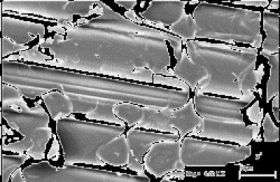Researchers have developed a process to coat Kevlar with germ-fighting agents, including antibacterial and antiviral substances. Above is coated Kevlar fabric exposed to a fungus called Candida tropicalis. Courtesy of the American Chemical Society
Protective clothing worn by firemen and other emergency workers may soon get a germ-fighting upgrade. Researchers in South Dakota report progress toward the first Kevlar fabrics that can kill a wide range of infectious agents, including bacteria, viruses, and the spores that cause anthrax. Their study is scheduled for the August 6 issue of ACS' Industrial & Engineering Chemistry Research.
In the new study, Yuyu Sun and Jie Luo point out that Kevlar fabrics are widely used as fire-resistant materials for firefighters, police and emergency medical workers. But amid increased threats of bioterrorism, there's a growing need for new protective clothing that can also provide multiple protection against a wide variety of dangerous microorganisms.
The scientists developed a special process to coat Kevlar samples with acyclic N-Halamine, a potent germ-fighting substance. They then exposed coated and uncoated fabric samples to E. coli, Staphylococcus aureus, Candida tropicalis (a fungus), MS2 virus, and Bacillus subtilis spores (to mimic anthrax).
After a short time, large amounts of microorganisms stuck to untreated fabric samples, but the coated fabrics showed little to no adherence of the infectious agents, the researchers say. The coating is long-lasting, can be reactivated, and does not cause any loss of fabric comfort or strength, they add.
Source: ACS
























